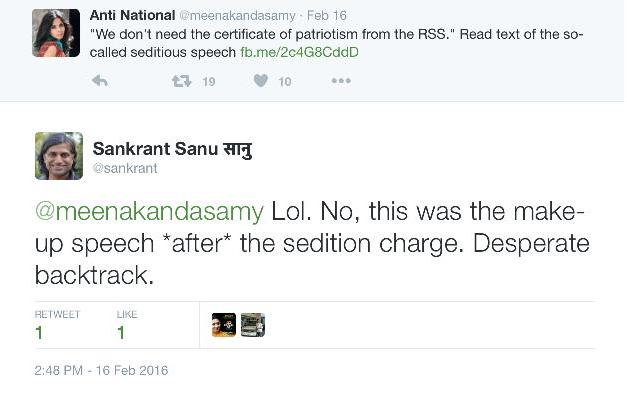The art of manufacturing international outrage
Noam Chomsky in The Hindu Feb 21, 2016
As Sevanti Ninan (The art of manufacturing nationalist outrage) and others have rightly pointed out, the incidents at JNU were blown out of proportion by some elements in the media. However, this sense of dis-proportion has been shown on both sides of the ideological divide.
Take the following front page of The Telegraph and Shekhar Gupta’s Tweet.


Both the cover and the commentary by Shekhar Gupta overhype the government response. No, there were no tanks rolling into JNU. Rather, the police acted on an FIR lodged by BJP MP Maheish Girri and footage provided by the JNU administration as well as the suo moto FIR based on the Zee News coverage.
But this did not prevent the exaggerations and hyperbole. The Telegraph picture, is by itself, strange. It shows a person allegedly being beaten up but there is not a scuff mark on his clothes, nor a scratch or even a hair out of place. To paraphrase Mark Antony, state repression should be made of sterner stuff. Yet, this story had all the elements in the art of manufacturing international outrage.
In the New York Times, Nilanjana Roy spun it as no less than “this imagined future, of true democracy and equality, is under siege” by the “toxic lies of the ruling Bharatiya Janata Party (B.J.P.) and its violent pseudo-nationalist propaganda.” In the Guardian, Priyamvada Gopal called it a “face-off between state repression and intellectual freedom … may well turn out to be a watershed moment for the country” where “the situation reminds many of the horrors of the 1975-77 state of emergency. “ To make such statement is an exercise in hyperbole with profound ignorance of the Emergency where thousands were jailed and the media censored, quite unlike the media broadsides against the government visible today. Not to be left out Xinhua jumped into the fray with “India's attempt to quash student dissent brings country's intolerance into focus”, perhaps hoping to paper over China’s far more restrictive free speech regime.
One area of persistent obfuscation in many media accounts, especially in international media, was the use of Kanhaiya Kumar’s speech of Feb 11 as the reason for his arrest, even though it was a speech given as a defensive measure, when he was anticipating arrest on the basis of the events on Feb 9. The Feb 11 speech was reproduced in The Telegraph with “The following day, Kumar was arrested on the charge of sedition” implying a relation between this latter speech and his arrest. That this confused enough people is evident below.
For instance, James Crabtree (@jamescrabtree) tweeted this question using The Telegraph article as reference: "Read the supposedly anti-national speech. Pretty baffled. What is all the fuss? All seems perfectly reasonable."
In Daily O, Angshukanta Chakraborty writes: “The "anti-nationalism" of Kanhaiya Kumar, if you listen to his speech (so, so brilliant) is similarly questioning the entrenched discriminations…”
This again mixes up Kumar’s speech on Feb 11, when he is fearing his imminent arrest, from the allegedly anti-national slogans on Feb 9, which is the reason for his arrest.
This theme is repeatedly found in SM as well where the Feb 11 speech is referred to as the “seditious speech.”


There were also several other threads that implied that Kanhaiya Kumar was arrested on the basis of doctored videos or “insufficient evidence.” Noam Chomsky, writing an open letter, reproduced in The Hindu,
“In a student meeting, acting well within the rights he possesses by the law of the land, Mr. Kumar spoke critically of the BJP government’s policies. On the previous day, at some other event, which he had no part in organising and at which he did not speak, a handful of other students, not even identifiable as students of the university, were shouting slogans about the rights of Kashmiris to independence from Indian military oppression over the last many decades. Mr. Kumar, whose speech (widely available on a video) cannot in any way be connected with the slogans uttered on the previous day, was nonetheless arrested for ‘anti-national’ behaviour and for violating the sedition laws against the incitement to violence. Since there is no evidence to establish these charges, we can only conclude that this arrest is further evidence of the present government’s deeply authoritarian nature, intolerant of any dissent…”
Prof. Chomsky cites the evidence from “most highly respected journalists” for these claims. It serves as an example of how media distortions results in the fallacies in Prof. Chomsky’s letter, that Kanhaiya Kumar “had no part in” the Feb 9 event. The Delhi police has categorically stated they possess substantial evidence that Kanhaiya Kumar “actually organized” the event. This evidence is both in official videos was collected by university authorities and eyewitness accounts. Media accounts on all sides jumped the gun in either making conclusions of guilt or dismissing videos as doctored with a judicial process underway. Secondly, it relies again on the speech on Feb 11 to assume that Kumar was arrested for dissent whereas the process for the FIR against him had started even before he gave the Feb 11 speech.
The net lesson is that the coverage has been ideologically charged from both “nationalistic” and “anti-nationalistic” perspectives. The biggest casualty of truth however is the spin that Kumar and other students were arrested for dissent against the BJP or the government where the issues on Feb 9 that led to the outrage were of “splitting India into pieces”, not related to any particular political dispensation in power. However, the latter accounts play out the political narrative of India’s new “intolerance” with the present government in power, that especially plays well to the international gallery.
It is time that both the “nationalist” and the self-professed “anti-nationalist” media lower the hyperbole in their coverage and stand down.
